Brightness and Contrast Ratio
For the brightness (luminance), contrast, and color accuracy tests, we depend on a hardware colorimeter and software to help calibrate the displays. We use a Monaco Optix XR (DTP-94) colorimeter and Monaco Optix XR Pro software, and we also test with ColorEyes Display Pro. Results in nearly every case have been better with Monaco Optix XR Pro, so we only report the ColorEyes Display Pro results on the monitor evaluation pages. We'll start with a look at the range of brightness and contrast at the default LCD settings while changing just the brightness level. (In some cases, it will be necessary to reduce the color levels if you want to achieve a more reasonable brightness setting of 100 or 120 nits.)
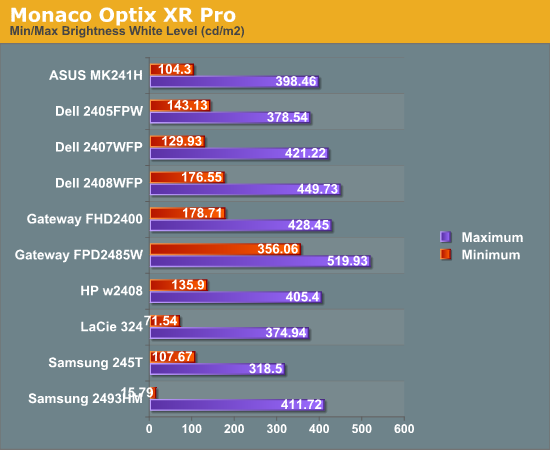
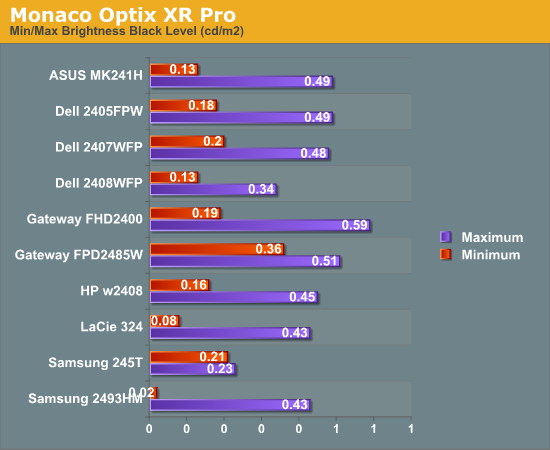
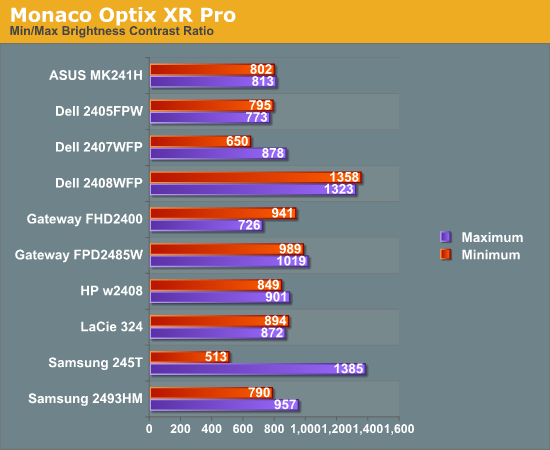
Nearly all of the LCDs have a maximum brightness level of around 400 nits, which is more than sufficient and is actually brighter than what most users prefer to use in an office environment. Minimum brightness without adjusting other settings is often above 100 nits, so it will be necessary to go in and adjust color levels as mentioned already. The Gateway FPD2485W is the prime example of this, where the default settings have a minimum brightness of 356 nits. Black levels are also reasonably consistent among the LCDs, with maximum and minimum black levels corresponding to the maximum and minimum white levels.
More important than the luminosity is the contrast ratio that is achievable at the various brightness settings. Here we begin to see some differences, with many of the LCDs following in the 800:1 ~ 900:1 range. The Dell 2408WFP and Samsung 245T stand out as having some of the highest contrast ratios, with the Dell taking the lead as it maintains the high contrast ratio even at low brightness settings. However, we should also mention that in practice the difference between 500:1 and 750:1 really isn't very significant for most users. It's only when you fall below 500:1 that colors really start to look washed out.
Color Gamut
We've already discussed color gamut of individual LCD evaluations, but it's a new addition to our LCD testing. This is something we wanted to add previously, but we lacked a good utility for generating the appropriate charts and data. We recently found out about Gamutvision, a utility developed by Imatest LLC. They were kind enough to provide us with a copy of their software, and it does exactly what we need. We compared the color profiles of all previously tested LCDs to the Adobe RGB 1998 color profile. Graphs of the individual gamut volumes are available on the evaluation pages. Below is a chart showing the percentage of the Adobe RGB 1998 gamut from the various displays.
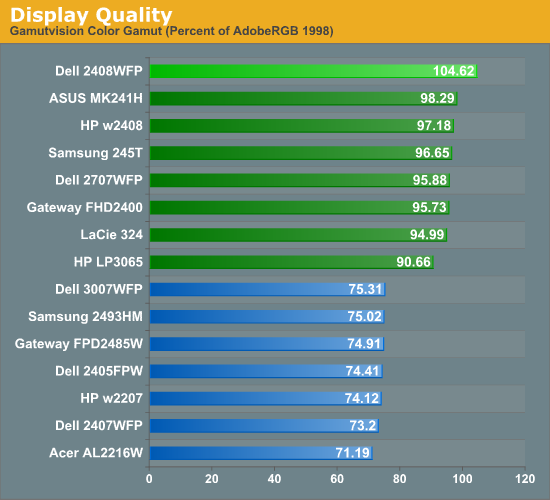
We basically end up with two tiers of quality in terms of color gamut. Filling the bottom tier are mostly older displays that have 82% NTSC color gamut backlighting. These may seem drastically inferior to the newer LCDs, but keep in mind that if you are just using the standard sRGB profile these LCDs look fine. It's only when you work in applications like Adobe Photoshop with its improved color space that you begin to notice a difference between the displays. Most of the newer displays now have ~95% Adobe RGB color gamuts, and the Dell 2408WFP actually surpasses the Adobe RGB 1998 color space. The only display in this round up that doesn't make it into the upper tier is the Samsung 2493HM.
Power Requirements
Another new test we decided to add with this roundup is a quick look at power requirements. Like the above tests, power requirements are checked at default LCD settings while varying the brightness setting. Also note that minimum power requirements are going to depend largely on how dim the backlight is at the minimum setting, so looking at the above charts it shouldn't be difficult to figure out that the Samsung 2493HM will require less power than the others when it's only putting out 16 lumens.
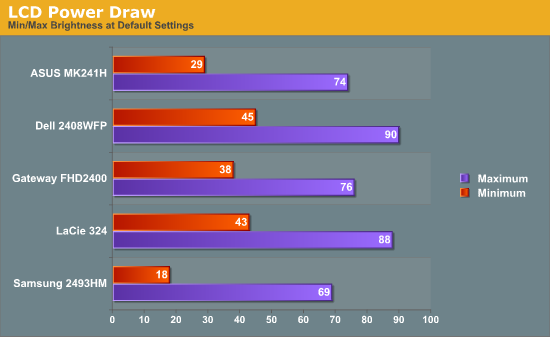
We've only begun collecting this data with this batch of LCDs, so we don't have any clear patterns established yet. However, it's interesting to note that the two S-PVA panels to seem to draw slightly more power than the three TN panels. At equivalent brightness settings, the differences in power draw are very small.










89 Comments
View All Comments
JarredWalton - Tuesday, May 6, 2008 - link
But that's exactly what I did in this review. Unless you mean a high-speed video camera that can record the changes in response to external stimuli (i.e. someone clicking a mouse).I think way too many people are losing sight of the forest because they're obsessing over the trees. I've given relative input lag, and it's accurate to 10ms for sure (and with averaging it should be accurate to around 3ms). At some point I may find an LCD that has a negative lag relative to the HP LP3065, and that's fine. As it stands, the best LCDs equal that LCD's lag.
Input lag as a whole is only one consideration of a display purchase, and differences of 3ms (or even 10ms) are not going to make you suddenly superior in games. 50ms? Sure, that's a potential problem, but anyone who has played online FPS games competitively knows that you have to learn to anticipate in order to compensate for network lag that may be anywhere from 50 to 150ms even with a high-speed connection.
If you want a display that offers minimal processing lag, so far the TN panels and 30" LCDs do great. I'd assume all the 22" LCDs do reasonably well, but having none in house at present I can't say for sure. Then everyone with S-PVA panels can call you an LPB.
jmunjr - Friday, May 2, 2008 - link
Though there are reports it now uses a TN panel, I am disappointed the Soyo Topaz S was not in this review. A bare bones S-PVA monitor for as low as $250 and easily $300 with no rebates? Ring me up! I have one and for the price it cannot be beat - period. At 24" TN monitors have too many shortcomings.bupkus - Friday, May 2, 2008 - link
I read this article this morning and then my gf calls me an tells me she has a $100 Dell credit that expires tonight.I thought, why not sell my Samsung SyncMaster 225BW and get this UltraSharp 2408? Starting Price... $679.00, that's why.
However, the E248WFP is on sale for $379.00. How does that compare?
Dashel - Friday, May 2, 2008 - link
Count me among those who want to know if it's even possible a revision will address the input lag on the Dell 2408. That's all that is holding me back from buying this monitor.Can they even get it down to 2407 input lag levels?
Finally BenQ G2400W, see if they wont give you one to review! That's my back up plan if the Dell doesnt pan out ;)
JarredWalton - Friday, May 2, 2008 - link
The best S-PVA panel has a 20ms lag on average. Note also that the Gateway FPD2485W uses a Faroudja chip and ends up with 20ms while the TN FHD2400 uses a Faroudja and gets ~0ms and LaCie does the same and gets 40ms. My guess is that somehow in the interest of colors or something else the S-PVA tech is delaying what you see on the LCD. The built-in scalers may also be inducing some delay, but the TN panels have scalers as well and don't suffer from any lag.Dashel - Saturday, May 3, 2008 - link
Isnt the 2407 an S-PVA as well though? You'd think they'd be able to at least match that level of input lag. That'd be enough to make me confident enough to buy one.As it stands, I'll have to see what revision A01 brings. I'll probably get one anyway. No 24" seems to have everything I want sadly. Good gaming non TN panel with plenty of inputs. The 2408 or that DoubleSight seems to come closest.
GTVic - Friday, May 2, 2008 - link
I would like to know if it is possible for game developers or hw manufacturers to develop controls in the games or in the driver control panel that would allow an adjustment for input lag. That way if you know you have a certain lag you can tell the game/driver to compensate.PPalmgren - Friday, May 2, 2008 - link
I highly doubt this would be possible.When I first hooked up my NEC 2470WNX, I played some DotA in (a Warcraft 3 map) and noticed after 5 minutes that I couldn't click on anything as well as usual. The funny thing is this isn't really aim-intensive, being an FPS. I tested it out and realized my mouse's response was delayed on the screen. I then noticed the same problem playing BF2 and NS a day later. It becomes impossible to aim quickly because you aim based on where your cursor is visible. However, your cursor is not where you see it on the screen, its still moving. Its a constant fight of over-compensation ruins your gameplay. The next week, I put my old Viewsonic 19' back up and still use it for games. I STRONGY suggest buying a TN panel for games, having experienced the short end of the stick.
GTVic - Friday, May 2, 2008 - link
I think it certainly should be possible.There a maybe a few types of lag. One is due to an overloaded graphics card that is not able to draw enough frames per second to properly update your mouse position so you don't know what you are shooting at. There is nothing to be done about that except buy a better graphics card or reduce the resolution/quality.
The other type of lag is when the game thinks one frame is being displayed and due to delays down the chain an older frame is being displayed. The game records your mouse click (gun fire) and calculates whether you hit the target based on the wrong frame.
The lag is not enough to cause the audio to be out of sync but if the game knew that the display was constantly 3 frames behind then it should be possible to correct the problem. Would be nice if Jared could investigate that with ATI/nVidia/game devs.
Dainas - Friday, May 2, 2008 - link
Oh you don't have to go to TN, I have two 24" P-MVAs that suffer from none of the blatant lag in the aforementioned panels. Both are verifiably faster than the 20ms 2407wfp and coming from a CRT I had none of the loose feeling in fast FPS like CS:Source and CoD4. All these slow panels are more in the realm of 40ms.need only look at this to know TNs do not have an unavoidable technical advantage over VA panels and its likely the manufactures putting IQ over response in most cases ;
http://www.digitalversus.com/article-357-3215-303....">http://www.digitalversus.com/article-357-3215-303....
But then again considering these panels are dissapearing from the market one might have to go TN afterall for gaming.